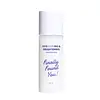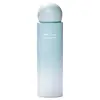What's inside
What's inside
 Key Ingredients
Key Ingredients

 Benefits
Benefits

 Concerns
Concerns

 Ingredients Side-by-side
Ingredients Side-by-side

Water
Skin ConditioningGlycerin
HumectantButylene Glycol
HumectantAcrylates Copolymer
3-O-Ethyl Ascorbic Acid
Skin ConditioningAllantoin
Skin ConditioningEthoxydiglycol
HumectantFerulic Acid
AntimicrobialAvena Sativa Kernel Extract
AbrasivePanthenol
Skin ConditioningSodium Benzoate
MaskingTriethanolamine
BufferingChlorphenesin
AntimicrobialPPG-13-Decyltetradeceth-24
EmulsifyingSodium Styrene/Acrylates Copolymer
Disodium EDTA
Polysorbate 20
EmulsifyingTocopheryl Acetate
AntioxidantPropylene Glycol
HumectantOryza Sativa Germ Extract
EmollientPentylene Glycol
Skin ConditioningTamarindus Indica Seed Gum
Emulsion StabilisingGlucose
HumectantGlycine Soja Seed Extract
Skin Conditioning1,2-Hexanediol
Skin ConditioningBeeswax
Emulsion StabilisingCitric Acid
BufferingPotassium Sorbate
PreservativeWater, Glycerin, Butylene Glycol, Acrylates Copolymer, 3-O-Ethyl Ascorbic Acid, Allantoin, Ethoxydiglycol, Ferulic Acid, Avena Sativa Kernel Extract, Panthenol, Sodium Benzoate, Triethanolamine, Chlorphenesin, PPG-13-Decyltetradeceth-24, Sodium Styrene/Acrylates Copolymer, Disodium EDTA, Polysorbate 20, Tocopheryl Acetate, Propylene Glycol, Oryza Sativa Germ Extract, Pentylene Glycol, Tamarindus Indica Seed Gum, Glucose, Glycine Soja Seed Extract, 1,2-Hexanediol, Beeswax, Citric Acid, Potassium Sorbate
Water
Skin ConditioningButylene Glycol
HumectantAvena Sativa Straw Extract
Skin ConditioningSodium PCA
HumectantPolysorbate 20
EmulsifyingSodium Hyaluronate
HumectantPotassium Hyaluronate
Skin ConditioningSodium Hyaluronate Crosspolymer
HumectantSodium Acetylated Hyaluronate
HumectantHydroxypropyltrimonium Hyaluronate
Hydrolyzed Hyaluronic Acid
HumectantHyaluronic Acid
HumectantHydrolyzed Sodium Hyaluronate
Skin ConditioningAllantoin
Skin ConditioningAzulene
Skin ConditioningStyrene/Acrylates Copolymer
Sodium Benzoate
MaskingTetrasodium EDTA
Water, Butylene Glycol, Avena Sativa Straw Extract, Sodium PCA, Polysorbate 20, Sodium Hyaluronate, Potassium Hyaluronate, Sodium Hyaluronate Crosspolymer, Sodium Acetylated Hyaluronate, Hydroxypropyltrimonium Hyaluronate, Hydrolyzed Hyaluronic Acid, Hyaluronic Acid, Hydrolyzed Sodium Hyaluronate, Allantoin, Azulene, Styrene/Acrylates Copolymer, Sodium Benzoate, Tetrasodium EDTA
Ingredients Explained
These ingredients are found in both products.
Ingredients higher up in an ingredient list are typically present in a larger amount.
Allantoin is a soothing ingredient known for its protective and moisturizingg properties. Because of this, it is often added to products with strong active ingredients.
Studies show higher concentrations of this ingredient can promote wound healing.
Though it can be derived from the comfrey plant, allantoin is produced synthetically for cosmetic products to ensure purity.
Learn more about AllantoinButylene Glycol (or BG) is used within cosmetic products for a few different reasons:
Overall, Butylene Glycol is a safe and well-rounded ingredient that works well with other ingredients.
Though this ingredient works well with most skin types, some people with sensitive skin may experience a reaction such as allergic rashes, closed comedones, or itchiness.
Learn more about Butylene GlycolPolysorbate 20 is made by combining ethoxylation of sorbitan, ethylene oxide, and lauric acid. It is a mild cleansing agent, surfactant, and emulsifier.
As a surfactant, it helps collect dirt and oils for washing. Emulsifiers prevent oils and water from separating.
Polysorbate 20 also adds scent to a product. Since it is made using sorbitol, it has a sweet scent. Sorbitol can also be found in fruits such as apples and peaches.
The lauric acid used to create Polysorbate 20 is often derived from coconuts.
Polysorbate 20 may not be fungal acne safe.
Learn more about Polysorbate 20Sodium Benzoate is a preservative. It's used in both cosmetic and food products to inhibit the growth of mold and bacteria. It is typically produced synthetically.
Both the US FDA and EU Health Committee have approved the use of sodium benzoate. In the US, levels of 0.1% (of the total product) are allowed.
Sodium benzoate works as a preservative by inhibiting the growth of bacteria inside of cells. It prevents the cell from fermenting a type of sugar using an enzyme called phosphofructokinase.
It is the salt of benzoic acid. Foods containing sodium benzoate include soda, salad dressings, condiments, fruit juices, wines, and snack foods.
Studies for using ascorbic acid and sodium benzoate in cosmetics are lacking, especially in skincare routines with multiple steps.
We always recommend speaking with a professional, such as a dermatologist, if you have any concerns.
Learn more about Sodium BenzoateWater. It's the most common cosmetic ingredient of all. You'll usually see it at the top of ingredient lists, meaning that it makes up the largest part of the product.
So why is it so popular? Water most often acts as a solvent - this means that it helps dissolve other ingredients into the formulation.
You'll also recognize water as that liquid we all need to stay alive. If you see this, drink a glass of water. Stay hydrated!
Learn more about Water